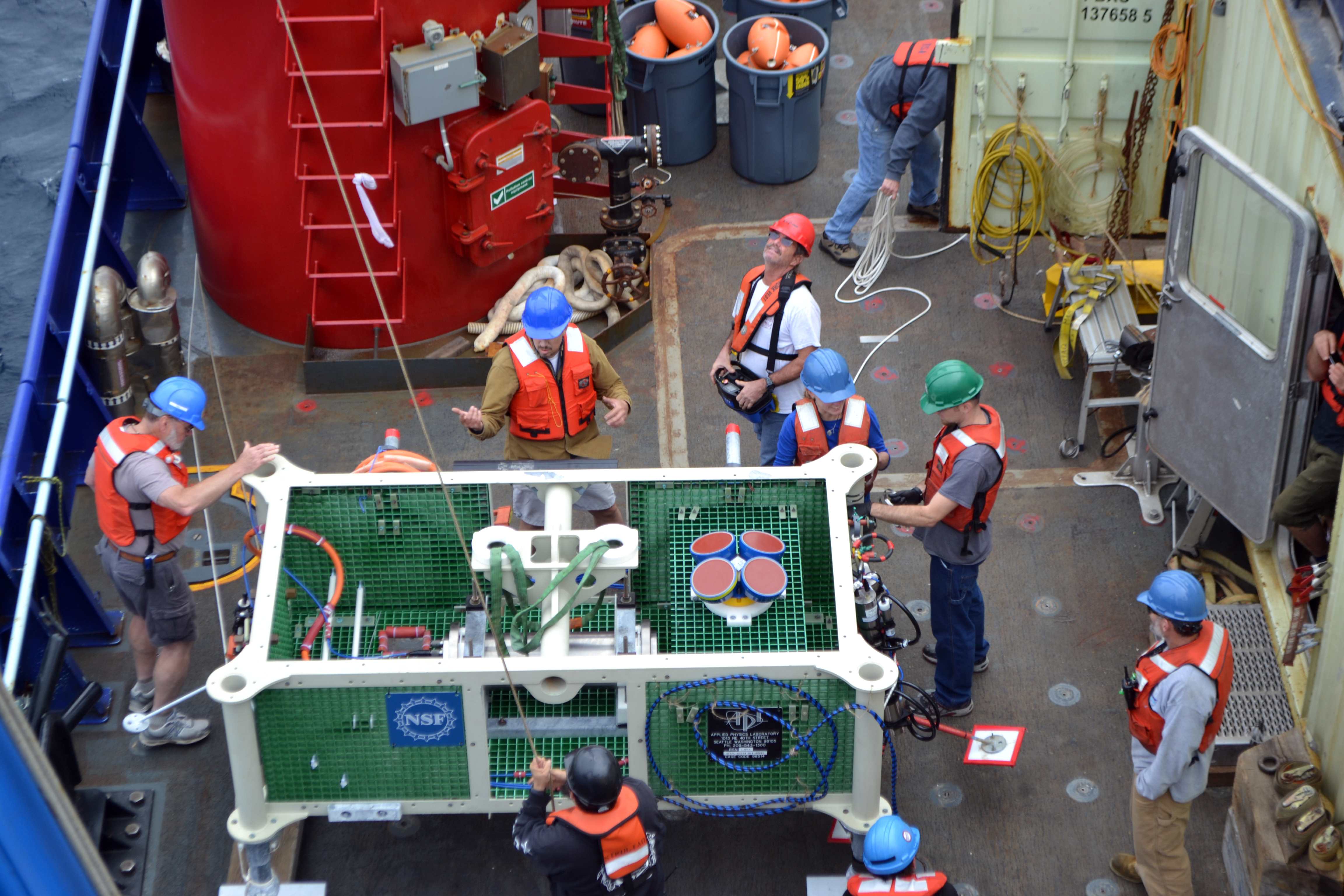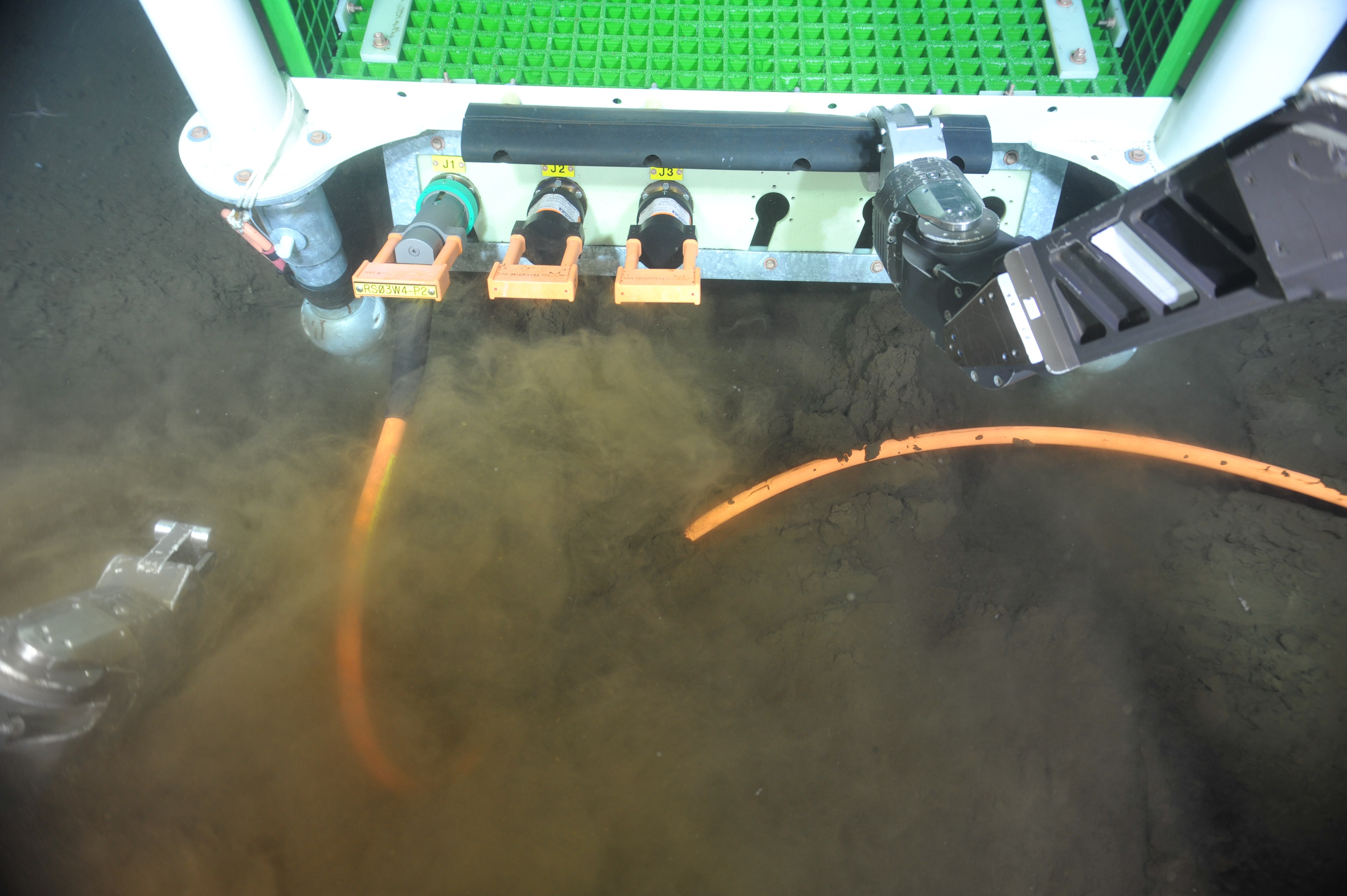Image Archive


















The ROV Jason plugs in the low-power junction box 9500 ft beneath the oceans surface at the Slope Base site. Credit: UW/OOI-NSF/WHOI, V16.

The engineeing team from the Applied Physics Laboratory at the UW and the crew of the R/V Sikuliaq prepare the low-power junction box for installation at the Slope Base site near the Cascadia Margin, 9500 ft beneath the oceans' surface. Credit. M. Elend, University of Washington, V16.

A 12 pin electrical wet-mate connector on a junction box at the base of Axial Seamount awaits its mate during turning of the platforms and instruments at this site. The oil-filled mates, allow the ROV to disconnect and connect extension cables on platforms, junction boxes, and instruments without bringing the entire assembly to the surface. They are used heavily on our system to reduce operations and maintenance costs. Credit: UW/OOI-NSF/WHOI, DIve J907, V16.

Junction Box LJ03A being moved into position at the start of Jason Dive 907. Credit: M. Elend, University of Washington; V16.

Junction box LJ03A cabled to the low-voltage node LV03A at the Axial Base site. Photo Credit: NSF-OOI/UW/CSSF, Dive 1736, V14

An overhead shot showing the spatial relationship between junction box LJ01A and low-voltage node LV01A at the Slope Base site. Photo Credit: NSF-OOI/UW/CSSF; Dive 1735; V14.

ROPOS lifting the broadband hydrophone mast on LJ01A into position. Photo Credit: NSF-OOI/UW/CSSF; Dive 1735; V14.

The port arm of ROPOS seating the plug connector of RS01W6 to J1 on Low Voltage node LV01A at the Slope Base site. Photo Credit: NSF-OOI/UW/CSSF; Dive 1734; V14.

A broadband seismometer and a low-frequency hydrophone placed on a flat basaltic plateau at the Axial Seamount Central Caldera Site, awaiting connection to medium power J-Box MJ03F. On a follow-on dive a 4.6-km cable will be installed. This area is of particular interest because the caldera floor is rapidly being uplifted, suggesting that melt is migrating into the magma chamber below. Credit: UW/NSF-OOI//CSSF; ROPOS Dive R1725; V14.

During ROPOS Dive R1724, the junction Box MJ03F was deployed at the Central Caldera Site. It will host a broadband seismometer, a low-frequency hydrophone, and a bottom pressure-tilt instrument suite. Photo credit: NSF-OOI/UW/CSSF; Dive R1726; V14.

On July 20, the medium-powere junction box MJ03C was installed in the International District hydrothermal vent field on ROPOS Dive R1717. It was connected to a ~2300-m-long cable (RSO3W6) that will connect this system to Primary Node PN3B. A temperature-resistivty sensor (TRHPHA301) is inside the J-Box, awaiting installation during a follow-on dive. Photo credit: NSF-OOI/UW/CSSF; Dive 1717; V14.

On July 18, 2014 the Low-Voltage Node LV03A was deployed at Axial Base. It was moved on R1715 to its final location. It will provide power and communications to two moorings to be installed at this site. Primary Node PN3A is to the right. Photo credit: NSF-OOI/UW/CSSF; Dive R1714; V14.

Medium-Power Junction Box MJ03C rests on the platform for ROPOS, awaiting connection to the underbelly of ROPOS. This node was installed on the seafloor during dive R1717.

The 1 km extension cable from the Primary Node PN3A at the base of Axial Seamount is connected to the low voltage node LV013A, which will feed the two moorings at this site. Photo credit: NSF-OOI/UW/CSSF; Dive R1717; V14.

An array of junction boxes and cables await installation during Leg 1 of the VISIONS14 expedition. This image was from the first few days of Leg 1. Photo Credit: Mitch Elend, University of Washington; V14.

This medium powered junction-box (MJ03B) in the ASHES hydrothermal field was installed during the VISIONS'13 expedition. The titanium cylinder inside the frame hosts the power converters, data ports, and communication capabilities to shore via the Primary Nodes. A 4.3 km cable extends from this J-Box across the caldera to PN3B, where it awaits future connection. MJ03B was installed as a 'subnet' during VISIONS'13 - two short-period seismometers are now connected to it via a 50 m and 1.2 km extension cable, respectively. A also host a cabled 3D thermistor array (a test instrument is shown in this image - triangular shaped frame with blue cables) was also deployed for testing. MJ03B, and all cables and connected sensors were fully tested during VISIONS'13, and are fully functional. During the several hour test period, several earthquakes were detected.

ROPOS enters the Pacific with a medium powered junction box attached to its underbelly. Photo by Marisa Gedney
- Anemone
- Animal
- Arthropod
- ASHES
- Axial
- Axial Base
- Axial Biology
- Axial Caldera
- Bacteria
- Basalt Lava
- BEP
- Biofouling
- biolgoy
- Biology
- Camds
- Camera
- Camhd
- Central Caldera
- Ciliates
- Cnidaria
- Coastal Biology
- Crab
- Deep Profiler Mooring
- Dive Highlights
- Eastern Caldera
- Echinoderms
- Endurance Array
- Engineering Team
- ENLIGHTEN 10
- Exploratorium
- Fish
- Geology
- HD Camera
- HPIES
- Hydrate Ridge
- Hydrates
- Hydrophone
- Hydrothermal Vents
- Illustration
- Inshore 80 Meters
- Instrument
- International District
- J-BOX
- Jason
- Jellyfish
- Junction Box
- K12
- Lava
- Mollusk
- Moorings
- Nodes
- Nudibranch
- Octopus
- OOI
- Oregon Offshore
- Oregon Offshore 600 m
- Oregon Shelf
- Oregon Slope Base
- People
- PN1B
- PN1D
- Polychaetes
- PPSDN
- Primary Node
- RASFL
- ROCLS
- ROPOS
- ROPOS Dives
- ROV Team
- RV Revelle
- RV Sikuliaq
- RV Thompson
- Salp
- Sample
- SC13
- Science Team
- Sea Cucumber
- Sea Star
- Sea Urchin
- Seafloor
- Seismometer
- Sensors
- Shallow Profiler Mooring
- Shark
- Shipboard
- Shore Station
- Slope Base
- Smoker
- Soft Coral
- Southern Hydrate Ridge
- Sponge
- Squid
- Students
- Students & Guest Participants
- Tmpsf
- Tubeworms
- VISIONS 11 Leg 1
- VISIONS 11 Leg 2
- VISIONS 11 Viewers
- VISIONS 13
- VISIONS 14
- VISIONS 15
- VISIONS 16
- VISIONS 17
- VISIONS 18
- VISIONS 20
- VISIONS 22
- VISIONS 23
- Visualization
